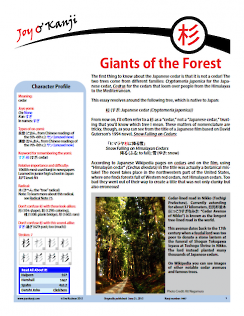杉
cedar
Kanji 1467
Thank you for visiting this Character Home Page. Below you'll find a synopsis of the essay. If you wish to read the full text, the PDF of the essay is available for purchase to the right.
Native to Japan, this towering tree lives 500 years—and more than two millennia on one island! Living cedars may be seen as sacred, receiving attention even from the emperor. Meanwhile, felled cedars turn into everything from soy sauce barrels to "magewappa." Discover unexpected relationships between cedar and saké, as well as between postwar reconstruction and pollenosis.
Revision history:
Oct. 31, 2024: p. 8: Added a missing line space to the quiz box.
Nov. 23, 2021: p. 9: Made several changes to the photo caption.
Jan. 16, 2020:
- p. 2: Etymology Box: Replaced the old Henshall etymology with the new one. Also removed the Sears image because for some reason he no longer has old images of 杉 on his site.
- p. 16: Added a link to the Kanshudo games.
Oct. 31, 2013:
- pp. 6 and 7: Slightly revised some info. in sentences.
- p. 11: Added a sentence about how cedar repels insects.
June 21, 2013: Originally published.



Comments